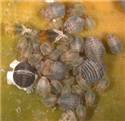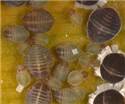Classification
Hormaphidinae: Cerataphidini
Common name(s)
Palm aphid, arecanut aphid
Diagnosis
Small, sedentary aphids with a dark brown, flattened, almost circular body fringed with white wax; legs short and hidden under body. Apterae 1.0-1.8mm long x 0.8-1.3mm broad, alatae 1.3-2.0mm. Antennae 0.18x as long as body. Processus terminalis 0.4 times as long as base of last antennal segment. Siphunculi pore-like. Cauda rounded.
It is impossible to distinguish this species from C. lataniae (Boisduval) in life, however slide mounted specimens can be separated by the presence of dagger shaped hairs on head.
Distribution
India (Karnataka, Tamil Nadu), Africa, Malaysia.
Host plant(s)
Arecaceae: Calamus rotang L., Calamus prosinus Lakshmana and Renuka.
Measurements
Aptera: Length of body 1.26, width 0.84; antennae 0.23, segments III: IV: V: 0.04: 0.03: 0.09: (0.05+0.02); u.r.s. 0.05; h.t.2 0.07.
Seasonal occurrence
February, September, November-December.
Natural enemies
Coleoptera: Coccinellidae: Cheilomenes sexmaculata (F.), Cryptogonus kapuri Ghorpade.


_sml.jpg)
_sml.jpg)


